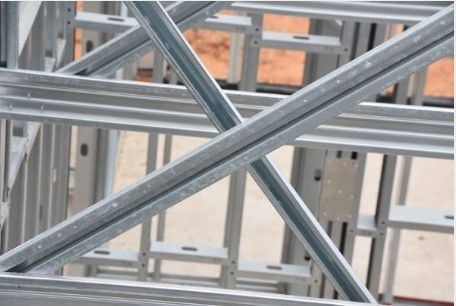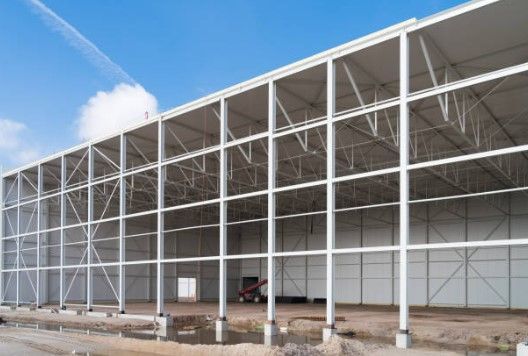778-403-1172
info@vancouversteelframing.com
Steel Studs & Framing Shield Your Property From Fires - Here's How
Traditional wood framing, while a common construction material, presents a significant vulnerability in fire scenarios.
Metal framing services from innovative 'steel framers near me' in the Greater Victoria area offer a superior alternative that enhances a building's fire resistance.
A 2014 study presented a promising simplified fire resistance design method for axially loaded thin-walled steel framing in wall panels exposed to parametric fires. This method was compared against results obtained from 236 finite element (FE) simulations for both heat transfer and structural analysis. It offers an efficient and potentially accurate way to assess the fire performance of steel framing assemblies.
Fire Safety Standards and Regulations in Canada
National Fire Code of Canada (NFC)
The National Fire Code (NFC) serves as the national benchmark for fire safety regulations in Canada. Developed by the Canadian Commission on Building and Fire Codes (CCBFC) and issued by the National Research Council Canada (NRC).
These regulations are designed to prevent fires and protect people and existing structures. Constantly evolving based on the latest research and technology, these codes are enforced by local fire departments and cover topics such as:
- Fire alarms
- Sprinkler systems
- Emergency exits
- Fire extinguishers
The National Fire Code, which is updated every five years, sets minimum standards for fire regulations in commercial or residential buildings. Compliance with the National Fire Code promotes fire safety in Canadian communities and helps insurance companies determine premiums.
Fire-Resistant Properties of Steel Framing
Non-Combustibility
Unlike wood, steel framing does not ignite or contribute fuel to a fire. This is a critical property as burning wood releases heat, which accelerates the fire's spread and intensity. Employing galvanized steel frames reduces the overall fire load within residential construction, commercial projects, or any type of structure.
High Melting Point
Galvanized steel boasts a high melting point—around 1538°C (2800°F). This is higher than the temperatures reached in building fires (around 538°C to 1100°C), which ensures the structural integrity of the metal studs even under prolonged exposure to intense temperatures.
Wood, in contrast, loses its structural integrity much faster as fire temperatures rise, which leads to the potential collapse of residential or commercial spaces.
Predictable Material Behaviour
Steel framing exhibits well-defined material properties, including its response to heat. This allows engineers in the Greater Victoria area to calculate the fire resistance rating of steel framing assemblies accurately for challenging projects.
This facilitates the design and architectural styles of safe and reliable fire compartmentation within a building structure. Fire compartmentation involves dividing a structure into fire-resistant zones to prevent flames from spreading.
Understanding Fire Resistance Ratings
The fire-resistance rating of steel framing walls, ceilings, or floors is not solely dependent on the galvanized steel itself. The overall rating is influenced by several factors:
Stud Profile and Thickness
Thicker steel studs (lower gauge) offer superior fire resistance compared to thinner ones
Insulation Type and Thickness
The type and thickness of insulation within the stud cavity impact the assembly's fire endurance. It offers superior thermal resistance, which slows down heat transfer through the metal framing assembly
Gypsum Board Facings
Gypsum board, commonly known as drywall, acts as a fire barrier. The thickness and type of gypsum board (regular or fire-rated) influence the overall thermal resistance rating. Fire-rated gypsum board contains additives that enhance its ability to resist fire.
Thermal Resistance Rating Achieved
Galvanized steel framing assemblies employing these elements can achieve thermal resistance ratings ranging from 1 to 4 hours, depending on the specific configuration of the entire process. This translates to a significant delay in fire spread and ensures durability while allowing occupants precious time to evacuate and firefighters to contain the blaze.
Steel Stud Framing vs. Common Framing Materials
In General:
| Steel Framing | Wood Framing | Concrete Framing | |
|---|---|---|---|
| Material Cost | Generally higher upfront cost | Wood had the lowest upfront cost | Higher upfront cost |
| Long-term Cost | Lower maintenance costs | Potentially higher maintenance costs | Lower maintenance costs |
| Strength | Very high strength-to-weight ratio | Good strength, but limited by size | Good strength, but limited by size |
| Fire-resistance | Excellent fire resistance | Poor fire resistance | Good fire resistance |
| Durability | Durable and resistant to rot and insects. But can be susceptible to corrosion if not maintained properly | Wood is susceptible to rot, insects, and fire | Very durable, but can be prone to cracks and breakage |
| Weight | Steel is lightweight | Wood is lightweight | Concrete is heavy |
| Construction Speed | Fast and easy to assemble | Moderate construction speed | Slow construction speed |
| Flexibility of Design | Can create large commercial spaces | Wood is easier to modify on-site | Can create complex shapes |
| Sustainability | Steel is highly recyclable | Renewable resource, but requires responsible forestry | Not very sustainable |
| Ideal Uses | Metal framing suits high-rise buildings, commercial buildings, bridges | Wood framing suits residential buildings, low-rise structures | Concrete framing suits basements, foundations, high-rise commercial buildings |
Steel frames Are Fireproof Compared to Wood and Concrete
Fire can damage residential and commercial projects, but galvanized steel and other metals are resistant to fire, unlike wood. This makes metals the better choice for residential or commercial construction. Metal framing is also beneficial in commercial buildings with higher fire risks, such as factories with overheating equipment, due to its fire-resistant qualities.
Proper Installation Techniques to Enhance Fire Retardancy of Steel Stud and Metal Framing
Metal Stud Selection and Handling
- Stud Gauge (Thickness): Use the appropriate stud gauge specified in the fire endurance design.
- Stud Condition: Inspect the metal studs for damage, such as warping, cracks, or excessive rust. Compromised steel studs can affect the assembly's overall thermal resistance and structural integrity.
- Stud Spacing: Maintain the specified stud spacing as per the thermal resistance design. Improper spacing can create weak points in the assembly, which reduces its fire endurance capabilities.
Fire-Resistant Insulation
- Insulation Type: Utilize insulation materials specifically designed for fire durability. Mineral wool insulation is a good choice due to its excellent thermal resistance properties.
- Insulation Installation: Ensure complete and continuous insulation fill within the stud cavity. Gaps or voids can create pathways for moisture and heat transfer. Follow manufacturer recommendations for packing density in existing structures.
- Compression Avoidance: Avoid compressing the insulation during metal framing installation. Compressed insulation loses its durability in slowing heat transfer.
Firestopping and Penetration Sealing
- Firestopping: Use approved fire-stopping framing materials to seal any openings within the metal stud assembly for pipes, cables, or other utilities. Firestopping materials expand under fire conditions, preventing flames and smoke from spreading through these openings.
- Penetration Sealing: Use fire-resistant sealants around service penetrations like electrical boxes or plumbing fixtures. These sealants prevent hot gases and flames from bypassing the gypsum board facings.
The Role of Routine Inspections in Maintaining Fire Safety
Understanding Fire Retardancy Degradation
Some factors contribute to the degradation of thermal resistance in metal stud assemblies over time:
- Physical Damage: Direct impact, accidental punctures, or improper handling during maintenance activities can compromise the integrity and quality of metal studs and gypsum board facings.
- Corrosion: Exposure to moisture or corrosive environments can lead to rust on metal studs, which can potentially affect their structural capacity.
- Insulation Issues: Settling or compaction of insulation over time can reduce its effectiveness in slowing heat transfer.
- Firestopping and Sealant Failure: Firestopping materials and sealants can deteriorate due to age, exposure to extreme temperatures, or improper installation.
Importance of Routine Inspections
Regular inspections help pinpoint potential problems early on, which allows for timely repairs and ensures the fire endurance of the assembly remains intact.
Here's how inspections contribute to fire safety:
- Early Detection of Damage: Inspections can detect any physical damage to metal studs, gypsum board, or fire-stopping materials before they impact fire endurance.
- Corrosion Control: Early identification of moisture-related issues allows for the implementation of protection measures or the replacement of affected steel studs.
- Maintaining Insulation Integrity: Inspections can identify any issues with insulation fill or compaction, which allows for corrective actions to restore its effectiveness.
- Firestopping Verification: Regular checks ensure fire-stopping materials and sealants remain functional and effectively prevent fire and smoke spread.

Optimize Fire Safety with Quality Steel Framing
Metal stud framing offers superior thermal resistance performance compared to traditional wood framing methods in residential construction and commercial spaces. By leveraging precision design methods with a comprehensive understanding of fire security regulations, metal stud framing services can effectively utilize metal studs to create fire-safe structures.
If you're looking for a metal stud framing solution with an unwavering commitment to quality results, Victoria Steel Stud Framing can be your valuable partner in your next metal framing project. Discuss your specific needs today.
Frequently Asked Questions
Can steel studs be recycled after use in a building, and how does this impact sustainability?
Galvanized steel is a highly recyclable material. At the end of the building process and lifespan, steel studs can be dismantled and reprocessed into new steel products. This reduces the need for virgin steel mining and associated environmental impacts.
Can I hang cabinets or TVs on metal stud interior walls?
Hanging cabinets and TVs on metal stud walls are achievable with the right approach.
- Confirm the total weight of the item, including contents, doesn't surpass the metal stud's capacity.
- Consult the manufacturer's specifications for both the item and fasteners.
- Utilize a stud finder to locate the steel supports behind the drywall, as this ensures the strongest hold.
- Choose toggle bolts or heavy-duty drywall screws designed for hollow exterior walls. These fasteners expand within the stud cavity for a secure grip.
- To distribute weight evenly for heavier items, consider using multiple fasteners across several studs.
Are Metal Studs Load-Bearing?
Not all metal studs are load-bearing, but they can be. Lightweight metal studs are cheaper and used for non-load-bearing structures like interior walls, partitions, or half walls. Load-bearing studs, made from heavy gauge metal, are used in exterior walls and load-bearing interior walls.
